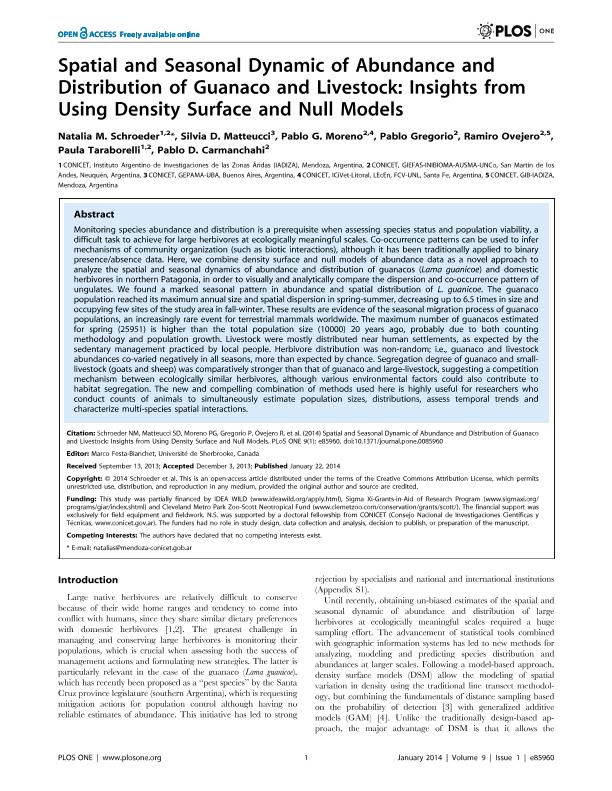Artículo
Spatial and seasonal dynamic of abundance and distribution of guanaco and livestock: insights from using density surface and null models
Schroeder, Natalia ; Matteucci, Silvia Diana
; Matteucci, Silvia Diana ; Moreno, Pablo Gastón
; Moreno, Pablo Gastón ; Gregorio, Pablo Francisco
; Gregorio, Pablo Francisco ; Ovejero, Ramiro; Taraborelli, Paula Andrea
; Ovejero, Ramiro; Taraborelli, Paula Andrea ; Carmanchahi, Pablo Daniel
; Carmanchahi, Pablo Daniel
 ; Matteucci, Silvia Diana
; Matteucci, Silvia Diana ; Moreno, Pablo Gastón
; Moreno, Pablo Gastón ; Gregorio, Pablo Francisco
; Gregorio, Pablo Francisco ; Ovejero, Ramiro; Taraborelli, Paula Andrea
; Ovejero, Ramiro; Taraborelli, Paula Andrea ; Carmanchahi, Pablo Daniel
; Carmanchahi, Pablo Daniel
Fecha de publicación:
01/2014
Editorial:
Public Library Of Science
Revista:
Plos One
e-ISSN:
1932-6203
Idioma:
Inglés
Tipo de recurso:
Artículo publicado
Resumen
Monitoring species abundance and distribution is a prerequisite when assessing species status and population viability, a difficult task to achieve for large herbivores at ecologically meaningful scales. Co-occurrence patterns can be used to infer mechanisms of community organization (such as biotic interactions), although it has been traditionally applied to binary presence/absence data. Here, we combine density surface and null models of abundance data as a novel approach to analyze the spatial and seasonal dynamics of abundance and distribution of guanacos (Lama guanicoe) and domestic herbivores in northern Patagonia, in order to visually and analytically compare the dispersion and co-occurrence pattern of ungulates. We found a marked seasonal pattern in abundance and spatial distribution of L. guanicoe. The guanaco population reached its maximum annual size and spatial dispersion in spring-summer, decreasing up to 6.5 times in size and occupying few sites of the study area in fall-winter. These results are evidence of the seasonal migration process of guanaco populations, an increasingly rare event for terrestrial mammals worldwide. The maximum number of guanacos estimated for spring (25951) is higher than the total population size (10000) 20 years ago, probably due to both counting methodology and population growth. Livestock were mostly distributed near human settlements, as expected by the sedentary management practiced by local people. Herbivore distribution was non-random; i.e., guanaco and livestock abundances co-varied negatively in all seasons, more than expected by chance. Segregation degree of guanaco and small- livestock (goats and sheep) was comparatively stronger than that of guanaco and large-livestock, suggesting a competition mechanism between ecologically similar herbivores, although various environmental factors could also contribute to habitat segregation. The new and compelling combination of methods used here is highly useful for researchers who conduct counts of animals to simultaneously estimate population sizes, distributions, assess temporal trends and characterize multi-species spatial interactions.
Archivos asociados
Licencia
Identificadores
Colecciones
Articulos(ICIVET-LITORAL)
Articulos de INST. DE CIENCIAS VETERINARIAS DEL LITORAL
Articulos de INST. DE CIENCIAS VETERINARIAS DEL LITORAL
Articulos(INIBIOMA)
Articulos de INST. DE INVEST.EN BIODIVERSIDAD Y MEDIOAMBIENTE
Articulos de INST. DE INVEST.EN BIODIVERSIDAD Y MEDIOAMBIENTE
Citación
Schroeder, Natalia; Matteucci, Silvia Diana; Moreno, Pablo Gastón; Gregorio, Pablo Francisco; Ovejero, Ramiro; et al.; Spatial and seasonal dynamic of abundance and distribution of guanaco and livestock: insights from using density surface and null models; Public Library Of Science; Plos One; 9; 1; 1-2014; 1-12; E85930
Compartir
Altmétricas



